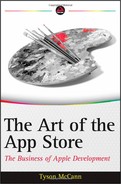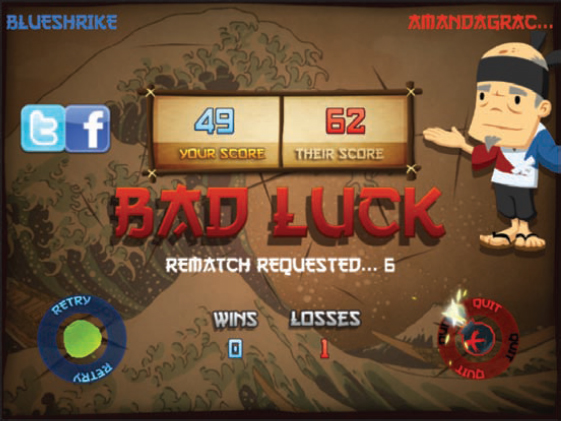SOCIAL INTERACTION AS FEATURES
When marketing your app, bullet points count, especially in the App Store description and for reviewers. To that end, what you can and cannot market as valuable social features should be noted.
Features versus Extras
As you've seen, social promotion of your app is important, but throwing in Facebook Connect or (as in iOS 5) the capability to Tweet events or share achievements does not make your app a “social” app, or encourage users to download it on these merits alone. Neither does the capability to promote it via e-mail, though it is a feature most apps should have. These types of social interactivity are extra features that can both help promote and extend its value, but they hold little value as bullet points for marketing these days, because they are both simple to do, and most apps feature some sort of social connectivity (or are trending that way).
Social features, on the other hand, are meant to be marketed and called out in your App Store description, whereas social extras might be the last bullet point, but certainly not the first. A social feature would be the capability to directly go head-to-head against or play along with friends, in-game chat or message, share photos, or collaborate. As you're developing your app, see if you can implement social features that provide more marketing mileage, versus social extras, which should be included, but are generally less meaningful.
Because apps with a form of competition, cooperation, or collaboration are becoming more frequent (take a look at all the Web 2.0 apps that feature collaboration), let's take a look at some of the ways to accomplish this in your own app so that they can stand out as key marketable features.
Setting the Stage for Users to Compete
Social gaming started with multiplayer features, which have been around from the earliest systems. Multiplayer features have, of course, evolved so that players can play remotely (the next big innovation), then chat, and now groups of friends can compete or co-op (play cooperatively) together with live chat or video, or even as artificial intelligence (AI) entities.
Multiplayer gaming has become so ubiquitous with most every game that games without it are often penalized in reviews. For example, the successful Action/RPG Indie hit “Torchlight” from Runic Games (which can be considered a more casual “Diablo”) released in late 2009 as a single-player only experience. Critical reviews were overwhelmingly positive, except for the one levied against a lack of multiplayer or even co-op. “Torchlight 2” includes multiplayer capabilities.
For iOS devices, currently the four social gaming platforms described earlier in the chapter can help you accomplish this: Game Center, OpenFeint, Plus+, and Facebook. As stated earlier, unless you have specific needs or are already enmeshed in Facebook, OpenFeint, or Plus+, it makes sense to provide at least Game Center support in most new games, but there are cases where you will want multiple options.
To provide the best experience, you have important considerations for specific types of games. Let's look at some of the key variations and conventions for implementing competition or cooperation in iOS games. Because literally dozens of combinations and hybrids of genres exist, the following list can be combined or mixed to suit the needs of your game, depending on genre and features.
Following are some important general considerations:
- Matchmaking — Whenever pitting one user against another, it is useful to have trackable metrics based on user profile, such as experience earned, win/loss ratios, score, and so on. Many matchmaking algorithms are available out there, so find or create one that suitably matches players of roughly equal skill. It can be frustrating for players to be matched with both a person too high above their skill level and too low, because no challenge translates into boredom.
- Lobbies — In any venue where you are pairing one or more people against others, it is often useful to have a “lobby” as a waiting room. Game Center features one without a lot of possible interaction between players. You should consider chat and messaging, and possibly other fun interactivity during the waits.
- Leaderboards — Anything with a score should have leaderboards, in any genre, but they are almost always found in these genres. Game Center and other networks support these, and you can also add your own, though these days it might be best to integrate with one of the main networking options discussed earlier in this chapter.
Following are some multiplayer and social connection possibilities:
- Team-based — Teams can be a fun mechanism and provide a strong sense of community, especially with direct friends. This is a favorite style in first person shooter (FPS) death match games, and even real-time strategy (RTS). Other genres can make creative use of teams as well.
- Co-op — Running through a game or level cooperatively is a favorite way to play among many players in everything from FPS games to RPS, but is a little more difficult to balance because of the typical need to design encounters for both single and multiple players.
 Regardless of genre, games with co-op can feature this in a huge marketing bullet point, because it's not as common as the other methods, in large part because of design complexity.
Regardless of genre, games with co-op can feature this in a huge marketing bullet point, because it's not as common as the other methods, in large part because of design complexity. - Head-to-head — Direct competition can be found in almost any genre, from fighting to RTS to FPS to casual and educational.
- Live chat — This is most often used in FPS or other action-oriented games where it is not always feasible to stop and type, but this will continue to gain more popularity as technology improves.
- Direct messaging and chat — This is a popular mode of connection in social and casual puzzle games, such as “Words with Friends” by Zynga. It should be considered anytime users are pitted against one another.
- Live video — This is currently viable mostly only in apps that are centered around the technology, because it can be expensive to implement programmatically, in addition to the casual user not being quite familiar with this yet. Like live chat, this will continue to gain in popularity.
Let's take a look at an example of how “Fruit Ninja HD” has implemented direct head-to-head multiplayer features using Game Center, and subsequently integrated results using OpenFeint in order to share via Facebook or Twitter. That's a lot of options.
First, players are given the standard option of a multiplayer game, and then are taken to a menu of options, as shown in Figure 10-13
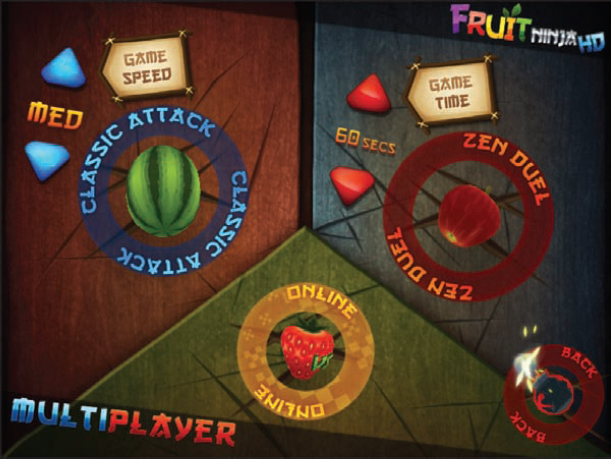
FIGURE 10-13: Multiplayer options in “Fruit Ninja HD” include a couple of head-to-head split-screen modes, as well as an online head-to-head mode
After tapping Online, players get the Game Center pop-up with just a couple of options (and this is likely to be improved in the future) — either play now via Auto-Match, or Invite a Friend. Inviting a friend uses the same dialog, and you are able to select from online Game Center friends. In this example, Play Now is chosen, as shown in Figure 10-14.
When a match is found, players are taken to a splash loading screen with easy-to-digest rules, and then the match begins after a short countdown. As shown in Figure 10-15, in this game, players take turns swiping their own colored fruit all on the same screen, and get subtracted points if swiping the wrong color. (It looks like the author is losing this one.)
When the battle is finished, the results screen shown in Figure 10-16 appears, where an option to rematch is provided, as well as social options to share results.
Finally, the player can tap the social button with Twitter and Facebook icons, and is taken to OpenFeint's social page for sharing. Now, if “Fruit Ninja HD” didn't have OpenFeint, the developers could have opted for Facebook Connect or the Twitter API to share the news instead (though, in iOS 5, as explained in the next section, Twitter functionality has changed).
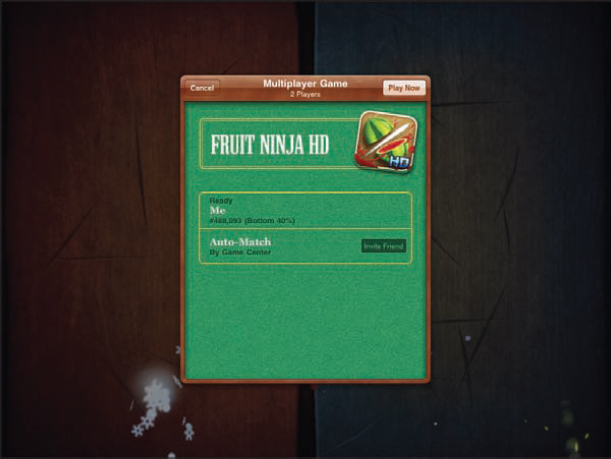
FIGURE 10-14: Game Center's current and rather sparse lobby will likely be the target of improvement in future versions of iOS
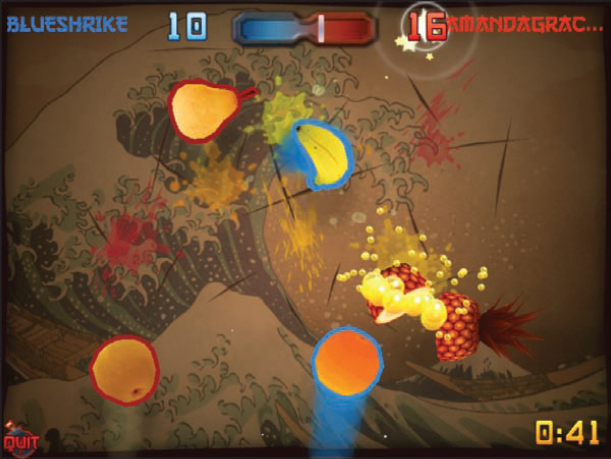
FIGURE 10-15: Head-to-head battle in “Fruit Ninja HD” using Game Center's Auto-Match feature
FIGURE 10-16: The results screen in “Fruit Ninja HD,” with rematch and social options using Twitter and Facebook
